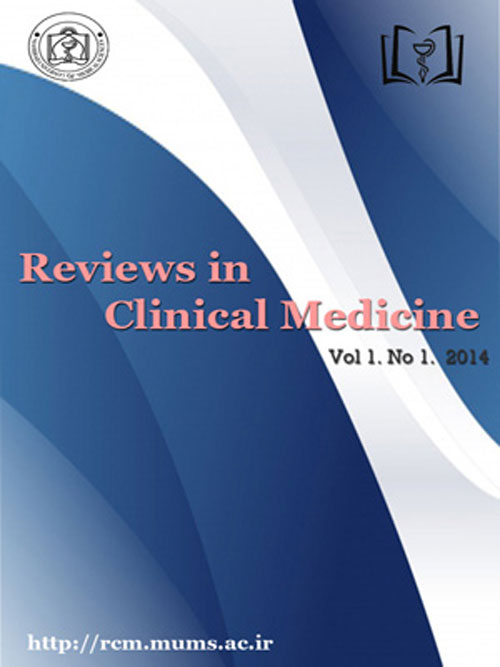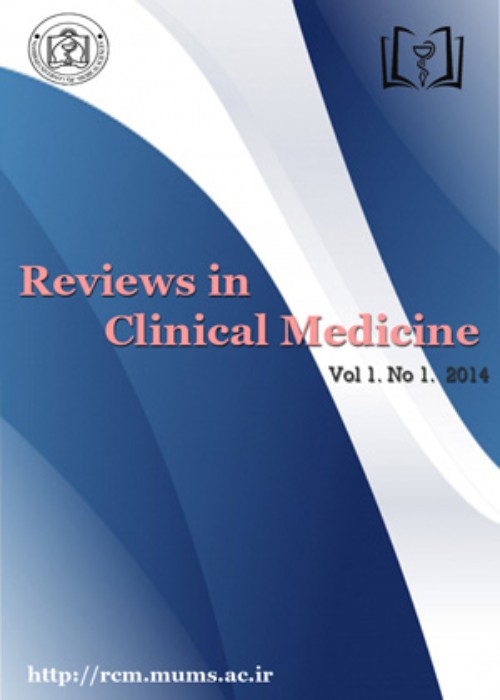فهرست مطالب

Reviews in Clinical Medicine
Volume:7 Issue: 1, Winter 2020
- تاریخ انتشار: 1399/01/11
- تعداد عناوین: 8
-
Pages 1-4IntroductionNowadays, fake doctors, known as “Bandis” in our country Iran, represent themselves as traditional healers and use superstitious ideas for the healing of the ill, especially children. Their activities do not comply with any scientific methods. No research has been focused on this issue. The present study aimed to evaluate the education and social levels of the patients and their reasons for referring to these quackeries.MethodsThis cross-sectional study was conducted on 1,300 children who were managed in the pediatric clinics of Dr. Sheikh Hospital for children, which is a tertiary care center in Mashhad, Iran. Informed consent was obtained from the guardians and patients. Upon examination, the parents of the children were asked to complete a checklist for data collection. Data analysis was performed in SPSS version 16, and the P-value of less than 0.05 was considered statistically significant.ResultsIn total, 1,300 children (621 females and 679 male) aged 2.5-12 years (mean age: 5.3±2.9 years) were enrolled in the study. Among the guardians, 62.5% were familiar with traditional healers, and 457 (37.2%) of the respondents had visited these individuals at least once. In addition, 106 of these cases had visited traditional healers more than three times. The parents were enquired about the reasons for visiting traditional healers instead of physicians, and 46.7% believed the applied methods by these individuals to be more effective. Moreover, 3.1% mentioned the lower treatment costs compared to physician visits, 2.9% reported the acute diseases of their children that did not respond to medical treatments, and 47.3% acknowledged those methods as real traditional practices.ConclusionAccording to the results traditional healers, are a major public health concern. For unjustified reasons, many people prefer their methods to conventional medicine. Therefore, healthcare authorities must raise public awareness in this regarding through systematic plans in order to prevent future complications.Keywords: Children’s Diseases, superstitious, Traditional healers, Treatment
-
Pages 5-9Introduction
Gallbladder stone and sludge are common diseases worldwide. The causes of gallbladder stone and sludge are numerous. Since some studies have reported the effects of thyroid hormones on the function of the sphincter of Oddi and biliary discharge, the present study aimed to evaluate hypothyroidism as a risk factor for gallbladder stone formation.
MethodsThis case-control study was conducted on patients whose sonography indicated gallbladder sludge or stone and those referring to our clinic with pain in the right upper quadrant of the abdomen. All the patients were initially examined by a sonologist to confirm gallbladder stone and sludge. Afterwards, thyroid function tests (TSH, T4, and T3RU via radioimmunoassay) were requested for the patients, and the results were analyzed and compared with the control group.
ResultsAmong 318 patients, 171 (53.77%) were male. In the case group, six females (8.4%) and 10 males (11.2%) had hypothyroidism. Overall, 9.9% of the patients (n=16) had hypothyroidism. In the control group, the prevalence of hypothyroidism was 2.5% (n=4) (OR: 2.082; 95% CI: 1.022-11.046; P=0.017). In the case group, 4.3% (n=7) had subclinical hypothyroidism, and 5.6% (n=9) had clinical hypothyroidism, while in the control group, only 1.9% of the patients (n=3) showed signs of subclinical hypothyroidism, and 0.6% (n=1) showed signs of clinical hypothyroidism. In the patients with gallbladder sludge and stone, the prevalence of clinical hypothyroidism was higher than subclinical hypothyroidism.
ConclusionAccording to the results, hypothyroidism was prevalent in the patients with gallbladder stone and sludge. Therefore, it is recommended that the thyroid function of patients with gallbladder stone and sludge be examined even if the patients do not harbor any other risk factors for the disease.
Keywords: Gallbladder Diseases, Gallstone, Hypothyroidism -
Pages 10-14IntroductionThis study aimed to investigate the effect of phacoemulsification on macular thickness and volume in diabetic patients without retinopathy using optical coherence tomography (OCT).MethodsThis prospective study included 37 diabetics and 55 non-diabetic patients (n=92) with cataract who were scheduled for phacoemulsification. The participants were entered into the study based on the inclusion and exclusion criteria following a complete eye examination. Macular thickness and volume were measured preoperatively as well as one month postoperatively using the OCT (Spectralis; Heidelberg Engineering, Heidelberg, Germany).ResultsThe present study analyzed 76 eyes of 76 patients with immature cataract. No significant differences were observed between diabetic and non-diabetic groups in terms of thickness and volume in the macular area. However, the results showed a significant increase in both groups regarding the thickness and volume after phacoemulsification.ConclusionThe results of the present study reveal that diabetes has no effects on the changes in macular thickness and volume after cataract surgery in diabetic eyes without retinopathy.Keywords: Diabetes, Optical coherence tomography, Phacoemulsification, Retinal thickness
-
Pages 15-19IntroductionPoisoning is the most common method of non-fatal suicide. In recent years, poisoning caused by the use of medications and chemicals has increased. The present study aimed to investigate the rate of suicide using toxic compounds in Iranian children.MethodsThis retrospective study was conducted using the data of 83 children aged 5-16 years who attempted suicide using toxic substances and were admitted to the pediatric and toxicology departments of Imam Reza Hospital in Mashhad, Iran.ResultsAmong 500 suicide cases, 83 committed suicide using toxic substances, and 8.4% of the suicides were committed by children aged 5-7 years. In addition, 60% of the suicide cases were aged 14-16 years. In total, 45.5% of the children committed suicide with prior planning (statistically significant). The peak time of referral to the emergency department was between 6-12 PM, and more than 90% of the patients were admitted with stable vital signs. The most commonly used toxic substance was organophosphate. During admission, psychiatric counseling was not provided to 36.1% of the patients, and the clinical outcomes also showed the use of non-lethal doses.ConclusionAccording to the results, it is of utmost importance to assess the underlying causes of suicide attempts in early childhood (e.g., prior planning and antisocial behaviors), especially with the increased age of children to 14-16 years in such incidents.Keywords: Children, Suicide Attempt, Toxic Substances
-
Pages 20-23Introduction
Hypertension (HTN) is one of the most life-threatening disorders worldwide. Although some examinations have demonstrated an incidental relationship between blood pressure and serum level of 25-hydroxyvitamin D, there have been new exchanges of views with respect to the influence of low vitamin D levels in hypertension. This study aims to find out the relationship between hypertension and regular consumption of vitamin D.
MethodsA case-control study was conducted with regard to secondary data (SINA system) among people, aged 30 years old or older, registered in 2017-2018. A sample size of 1,500 patients was used comprising of 500 patients with hypertension as the case group and 1,000 people without history of hypertension as the control group. The population was selected randomly. High blood pressure diagnostic criteria were considered in the same manner with the clinical guidelines of the 7th National Joint Committee. Data were analyzed using SPSS 22 software.
ResultsRegular consumption of vitamin D had a protective role on hypertension (P value <0.05) and [OR= 0.421 (0.353- 0.505)].
ConclusionBy identifying hypertension risk factors, taking measures to prevent it would be more practical and the risk of hypertension can be reduced. An enormous volume of epidemiological and empirical proof is indicative of the fact that vitamin D deficiency can lead to high blood pressure. The present investigation proves that vitamin D supplementary may serve as a convenient method to diminish the risk of progression of increased blood pressure due to its protective effect on blood pressure.
Keywords: Hypertension, Risk Factor, Vitamin D -
Pages 24-29Introduction
Diabetes is the most common metabolic disorder during pregnancy. Given the importance of the screening and treatment of gestational diabetes for the prevention of maternal and fetal complications, the present study aimed to evaluate the prevalence of gestational diabetes mellitus in the pregnant women covered by Mashhad University of Medical Sciences, Iran.
MethodsThis study was conducted on the women with pregnancy intention or confirmed pregnancy, referring to the health centers affiliated to Mashhad University of Medical Sciences during March 2017-September 2018. The patients with gestational diabetes mellitus were identified based on the latest WHO criteria in 2013. Data were collected on the conducted experiments and recorded in the integrated health information system (SINA). Data analysis was performed in SPSS version 25 using Chi-square and logistic regression.
ResultsDuring the study period, 2,710 women (4.3%) were diagnosed gestational diabetes mellitus. The mean age of the patients was 28.5656.379 years. In terms of the influential factors, significant correlations were observed between gestational diabetes mellitus and family history of diabetes (OR=4.278; P<0.0001), history of gestational diabetes mellitus (OR=3.880; P<0.0001), body mass index (OR=2.302; P<0.0001), history of macrosomia (OR=1.656; P<0.003), history of recurrent miscarriage (OR=1.759; P<0.007), and preeclampsia (OR=1.914; P<0.045).
ConclusionAccording to the results, the prevalence of diabetes in Mashhad city (4.3%) seems to be slightly lower than other areas. Special attention must be paid to the pregnant women with the influential factors of gestational diabetes mellitus through selective screening based on the risk factors of the disease.
Keywords: Gestational Diabetes Mellitus, Prevalence, Risk Factor -
Pages 30-36Introduction
Diabetes mellitus (DM) is a metabolic disorder with a high prevalence, which affects approximately 25% of the world’s population. This systematic review aimed to assess the Iranian research regarding the effects of medicinal plants on pancreatic beta cells in diabetes.
MethodsThis systematic review was conducted via searching in databases such as Medline, PubMed, Google Scholar, and ScienceDirect until April 2018. The studied that were published in Iran, peer-reviewed, and designed as a randomized control trial on type I diabetes were retrieved and screened.
ResultThe initial search results of the electronic databases yielded 822 relevant articles. After two stages of screening, checking the references, and removing the duplicate articles in various databases, 18 articles were finally selected for the review.
ConclusionAccording to the results, medicinal plants have a positive impact on the performance of pancreatic beta cells in animal models through various mechanisms, such as increasing the number, size, regeneration, and reduction of the inflammation of beta cells.
Keywords: Diabetes Mellitus, Medical Herbssyndrome, Medical plants, Pancreatic Beta Cells -
Pages 37-42
Oxidative stress is an imbalance between the level of ROS and antioxidants. Sperm membranes are rich in polyunsaturated fatty acids and are very sensitive to increased free radicals. Increasing the level of ROS can lead to an increase in lipid peroxidation in sperm membrane, decrease in their flexibility, and ultimately a decrease in sperm motility. Also, oxidative stress may impair sperm axonemal and mitochondrial function, as well as DNA integrity, RNA and protein synthesis. Several studies have shown that antioxidants are beneficial to human health and are used to prevent cancer and coronary artery disease. Based on the present review, there are more documents in protective effects of antioxidants on sperm cells. Studies showed adding in vitro antioxidants to sperm samples can increase sperm parameters such as sperm motility, morphology and decrease sperm membrane lipid peroxidation and sperm DNA damage. Also in vivo or oral antioxidants supplementation has protective effects on sperm from ROS negative effects. Since the causes of infertility are various, the lack of antioxidants action in reducing the sperm DNA damage, the level of antioxidant activity depends on the type, dose and duration of intake, so more studies are needed to determine the appropriate antioxidant type, the dosage and timing of administration in vivo and in vitro.
Keywords: Antioxidants, Oxidative stress, ROS, Sperm DNA damage


